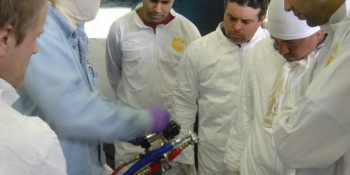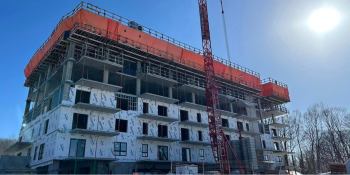Q&A Forums
Hybrid vapor barrier or not ? Post New Topic | Post Reply
| Author | Comments |
|---|---|
|
eric himmer
Posted: Jan 26, 2009 07:27 PM
|
Hybrid vapor barrier or not ?
I have seen conflicting info on this site and manufacturer sites regarding the proper placement or omission of a vapor barrier when doing a hybrid system. We are in southern Maine and have seen 2" CC sprayed to walls and covered with R-13/R-19 fiberglass both with and without vapor barriers on different job sites. Could you clarify which configuration is correct for our climate zone with 2" CC and fiberglass. And if we spray just 1" of CC does it change the configuration. Thank You |
|
SPFer
Posted: Jan 26, 2009 10:24 PM
|
I would highly recommend at least 2" of Closed cell, if not 2.5", especially in the cold climate of Maine. I try to stay away from flash and batt, especially with fiberglass batts. Any space between the batt and the foam will result in condensation. I prefer using a loose fill fiberglass or cellulose packed to the proper density to eliminate any air space between the foam and the other insulation method. Of course, I would try to sell you on eliminating the hybrid and using foam only. |
|
SPFer
Posted: Jan 26, 2009 10:29 PM
|
As far as the vapor barrier question, I have my doubts about this as well. 2" of closed cell foam creates a vapor barrier. That puts your vapor barrier on the cold side of the wall. In cold climates the vapor barrier should be on the warm side. If you then put a vapor barrier on the warm side, now you have two vapor barriers and no place for moisture to escape. Any thoughts, comments on the hybrid vapor barrier issue? |
|
mason
Posted: Jan 27, 2009 07:39 AM
|
Hybrid systems are a combination of closed cell SPF and a higher perm rated insulation such as fiberglass or cellulose. The theory is the closed cell foam creates an air barrier and vapor retarder sufficient to prevent the free flow of moisture into the wall cavity while separating the inside and outside temperature sufficientlyh to prevent condensation. In colder climates building scientists agree that 2-3 inches of closed cell SPF would suffice to prevent condensation in typical indoor environments. Dr Mark Bomberg recommends 50 mm of foam (2 inches). WUFI simulations indicate 2 to 2.5 inches is sufficient. Neal Ganser with CorBond is more conservative based on his observations in Montanna and recommends 3 inches in the colder areas of the US. Joe Lstiburek offers a chart that specifies an R value of foam sufficient to prevent condensation that has been adopted by the ICC codes. The idea is to separate the interior environment (both temperature and humidity) with closed cell foam to the extent that the dew point is outside of the building envelope. Closed cell foam slows down the moisture flow and heat transfer sufficient to reduce this potential and in the drying months allows the moisture accumulated in the foam to come out towards the inside. 1 inch of closed cell would not be sufficient in the colder months from preventing a colder surface on the SPF from allowing condensation if your interior humidity gets in the 40-50% range. For example consider if you have 25% humidity and a temperature of 70 degrees F inside and an outside temperature of 15 degrees F. The dewpoint would be somewhere around 25 degrees. F. The foam wouuld have to keep the inside surface above 25 degrees. It would probably do that with little problem. But, raise the humidity to 45% and decrease the outside temperature to 5 degrees and you would have condensation on the foam. Hybrid systems using 1 inch of closed cell foam work on the theory that the fiberglass has a vapor retarder element to the face of it that prevents moisture vapor from going into the foam. Critics of this practice point out that the vapor retarder can be easily damaged during installation allowing moisture to creep into the wall cavity without a sufficient means to dry it out. Remember the foam has created an air barrier so moisture will not dry out to the outside from ventilation. So the conservative approach is to put at least 2 inches of closed cell foam before installing the higher perm rated material such as fiberglass or cellulose. Hope this helps |
|
Posted: Jan 27, 2009 12:22 PM
|
Mason, So if I am understanding this right a 1" cc hybrid system will actually make a moisture problem given the right circumstances,or should I say wrong circumstances. Just so I understand this, what you are saying is just batt alone will be ok in a wall cavity because of the air infiltration. Adding the foam flash now will cause the potential for a condensation issue because the foam will not allow enough air flow behind the batt,and the 1" will not be enough to provide or prevent dewpoint due to the temperature of the foam at the face. Lastly is this a theoretical issue or have real world problems been encountered with the flash and batt. In my opinion if you have to use 2" of cc what is the point of adding mineral insulation at all why not finish it off with all foam. Thanks for your input |
|
mason
Posted: Jan 27, 2009 08:52 PM
|
Well yes and no. You can have problems with 1 inch of closed cell foam under the right circumstances but you can also have trouble with just fiberglass. But as you suggested fiberglass in a wall cavity that has no air barrier will vent moisture easier to the outside, but also will condense more water than 1 inch of closed cell foam. Also, the fiberglass in the summer will allow warm moist air in the summer into the wall cavity which can then condense on the back of the sheetrock. As for what is the point of using a hybrid system if you have to use 2 inches of closed cell foam, the newer building codes call for up to R 49 in ceilings and R 21 in walls in cold climates So, the combination would be somewhat less expensive than just the closed cell foam by itself. |
|
Brian Ahrens
Posted: Jan 27, 2009 10:04 PM
|
Got a call the other day from an electrition who had worked on some jobs with us, said the house he was working at had water running out of the walls. He said there was foam in the walls and the owner wanted to know what should be done. After cutting an access hole they pushed the fiberglass to the side and found huge ammounts of frost on the face of the foam. Owner tore out all drywall and insulation on main floor and in the basement to find all outside walls soaked with water. Fiberglass installer had sprayed one inch max closed cell with a canister set and then batted. With the weather here in Iowa setting new record lows for the past three weeks it was a disaster waiting to happen. Be very careful when doing flash and batt it could cost your company dearly in price and reputation. This guy was lucky to catch the problem before he painted, but how many houses out there are finished and have water in the walls from this fiberglass installers incompitance. After the walls dried out we fixed the mess with real foam and in the process even gave the owner a good break on the price. Word of mouth is the best advertising you can get! I have turned down many flash and batt jobs due to the moisture problems it can create. Always wondered if I was doing the right thing, and after seeing this last mess, flash and batt will never be done by me! Good luck to those of you in the north,and stay warm |
|
Posted: Jan 28, 2009 09:24 AM
|
Thanks guys, I appreciate the input. as for the the need for mineral insulation over 2' of cc i was referring to wall cavities not attics. Here in our area we are required to put a R-19 in walls. The funny thing with batt insulation is that a labeled R-19 in a 2x6 wall is 17. So all we need up here is 2.5" in cavities to meet the required code. so for me that wouldn't make sense. As for the situation seen in Iowa I suspect this was new construction. I have seen it also,here would be my bet on the scenario. New construction curing concrete floor and basement walls,drying spackle and portable propane heaters. Let not take temporary conditions and consider them the norm. Remember build tight VENT right. I dont blame my mirror in my bathroom for fogging over when i fail to turn on the vent. I sprayed a full closed cell package a few years back 4" cathedrals R-30 and 3" sidewalls. The builder called me back and said they were having moisture problems. He said to me I told you we can't build this tight.It was what the homeowner wanted not the builder. When I got there what i saw was dew drops on some of the framing in the conditioned attic. The problem was not caused by the foam,what he had was the following. Drywallers spackling,tile guys in the kitchen,propane heaters and a concrete floor in the basement drying. The hvac system was not up and running so ventilation was not yet introduced and the RH in the house was over 90% you should of seen the windows. Also it was about 8degrees that day. If I had not known better I would of thought foam was something from the devil. We just need to remember that building envelope systems are designed to work in real world conditions, this was not a real world condition. |
|
Posted: Jan 28, 2009 09:12 PM
|
i have 300+ hybrid systems here in iowa,,, we have seen no water running out of walls,,, we recomend a vapor barrier over the glass,,, if there is condensation in a hybrid system,,that condensation would be there if the foam was there or not...it would be on the osb... remember the dewpoint is met and it usually condensates on the next available airspace,,,, we utilize hrv's as well,,and then we have paint on the walls for additional retardance as well,,, i would guess your electrician was in a place where it was just foamed-glassed and rocked,,,i would further to guess that no additional vapor retarder applied,,,cause the drywaller and the frothpackinfilterglassmaggot decided "you dont need it,,, this place has got foam in it",,,and now they got,,, lets see,,,a temporary propane furnace in the basement spewin out heat,,and moisture,,,and lets see about 2 or 3 155k torpedos on the main level addin to the heat and moisture,, so we can "put on some mud and get her done!!!" (did they tell ya how fast the place heated up for em when they were happy??) i would guess that the hrv/erv in the basement wasnt runnin yet,,,i would guess that the relative humidity was about 80+% in that building,,,drip it should,,run it should,,,and it will,,, hey man i saw this once to...i did the foam,,,filterglass dude was freakin out,,,he did a bibbs system and did not vb the wall,, the owner was freaked,,,the builder was freaked so,,,rather than being reactive,,,we got proactive,,,and guess what,,used science to remediate the problem...cause every one was blamin the foam,,,and it wasnt playin,,not on my watch (oh by the way,,i was on vacation remediating this over the phone,,,this coulda pooped on my parade real easy with my absense from the site,,thank you god!!but this industry is built on relationships,,and i cemented my relationship with that tri-state filterglass company,,,they like our system) so we dehumidify to remove the excess moisture from the process of heat and mud and tape,,,didgital monitering of the wall cavity for moisture content to ensure drying...so the owner could see it just wasnt voodoo,,,vacume extraction to assist in removal of gross water,, anyway the rock stayed on the wall,,, a vapor retardant coating system (paint for those of you from loma linda) was utilized for the vapor retarding membrane on the warm side of the wall,,and the hrv/erv does its job even better!! im sorry this is a bit hodge podge and rambling,, but my mind is mush... has anyone done any modeling? i mean whole wall modeling with all components of the wall system in place,,, i have,,,and do,,,and,,well,, sometime i will post the numbers i see for a hybrid system with proper building components utilized... i have been running it out with 1,2,3 in foam,,,glass no glass,,vb no vb,,paint,,no paint,, i will continue to spray the hybrid system,,, it works,,it does what it does.. it reinforces, creates and completes the building envelope,,,better controlling the unintended air movement into and out of the structure,,,(and ya know,,,blower door testing conferms it too!!)you have a filterglass insulation system that is performing better in crappy condtions where it losses most of its performance,,when we need it the most..you do not have the advantage of a full foam insulation package,,you want cheap,,you got cheap... ...please lord send warm weather so i stop modeling on the computer,,, 'dude ps: qbstoolbox dot com ,,,you'er welcome rick! |
|
mason
Posted: Jan 29, 2009 09:07 AM
|
Foamdude brought a few good points, the main one is each job is unique to the climate (indoor and out), the building materials used, and how the occupants use the building. The more people, pets and plants the higher the indoor humidity. The higher the temperature the more absolute moisture the room can hold (or the outside in warm climates.) You can reduce the overall humidity in the enclosed areas and prevent condensation or provide vapor retarder elements and insulation in the right places to accomplish the same things. If in doubt, perform moisture calculations (hygrothermal modeling) using a pyschrometric chart or modeling software (such as a WUFI simulation). For example, while I don't have a WUFI program, I can obtain a WUFI simulation on most applications for around $300. Others have that capability also. I strongly recommend that you don't use a one size fits all. It can get you in trouble. |
|
Brian Ahrens
Posted: Jan 29, 2009 08:13 PM
|
From everything that I have read on this site, in magazines,and been told by my manufacturer, you need two inches or more of foam in the wall to prevent condensation. I happen to believe the experts and strongly agree with them on this subject. Modeling is just numbers on a paper, it may point you in a general direction but cannot take into account all the vairables that happen in that house over the years. The real world is a much different place, and its not worth leaving me or my business exposed to lawsuits and aggerssive lawyers. Flash and batt may work or may not but it is not the right choice for me. I sleep much better at night knowing that the next call I take is not going to be from an unhappy customer or worse yet a lawyer. No offence to anyone on this board its a great place for all the foamers to learn, chat,and exchange ideas. |
|
Posted: Jan 29, 2009 08:35 PM
|
amen foamdude amen |
|
Posted: Jan 30, 2009 07:00 AM
|
lawyers like science... lawyers like salesman even more... flame on:::: an old wiseman once said: dont believe all you read,,unless you read a whole bunch,,, (and then theres the one about lips movin...but i digress) real world = 300+ applications and NO FAILURES no water runnin out of walls,,,no mold when we've done additions in the future,,,real world man,,,,no unhappy customers here either,,darned,,go figure... flame off:::: this is a great place to share ideas, information and thoughts and values... thank you sprayfoammagazine.com!! ....may i have another sir! |
|
eric himmer
Posted: Jan 31, 2009 06:06 AM
|
Thanks Mason and everyone else for the comments. This clears things up for me. I will probably not consider it in walls, but as Mason suggested it will sell some jobs when used in attics to keep the price down. |
|
Posted: Feb 02, 2009 06:33 AM
|
i would be concerned with a vb on the cold side of the wall with the 2" lift... and consider,,,put 3 or 4 good coats of paint on the drywall and you are approaching another vapor retaarding membrane,,,, so now any moisture vapor that enters the wall cavity is "trapped" in the cavity,,unable to either dry to the outside or back into the inside...as we have pretty good vapor retartding membranes on both sides of the wall... this is my reasoning for a 3/4-1" only cc for my building envelope,,,, so i modeled maine,,using 3 different cities,,the program really thru some high outdoor humidities,,,and i played with those numbers a bit,,as well as the numbers on the interior humididty..( is the humidity really that high out there??) interestingly,,with either the 1" or 2" system,,i was able to see condensation at the foam face AS I DROPPED THE OUTDOOR TEMP,,,to temps that well we easily saw here this winter,,,dont know about ME but is -15 out of range? the outside temp really had the most drastic effect on this,,,, im with neil from corbond on this one,,,2.5"-3" system is what it takes to stop the transfer of hot to cold suffeciently to prevent condensation in the cold climate wall system... just another manic monday... 'dude ...we have the means to reduce our dependance on foreign oil,,and domestic as well,,,, ...we have the means to build more energy efficient structures.... ....hope,,,for change,,,,for a better tomorrow... ...real change!!! |
|
Circle-D
Posted: Feb 03, 2009 10:24 PM
|
-15 not out of range at all foamdude. I was looking at work 2 weeks ago when it was -31 at one job and -35 at the other. Notice I said looking at work, not really doing it. Spring is just around the bend. |
|
Jim Coler
Posted: Feb 04, 2009 07:10 AM
|
We've had the same call as ATT. Electrician cutting in another outlet and the wall was compeletely wet inside. Also had a code official call and ask about it because he is seeing moisture behind the Filterglass in every house. I know some of the contrators installing the "hybrid" - "flash and crap" around here are only putting 1/4"-3/4" max. So, what happens to the wood studs when they get wet in a dark area? I here mold, mildew and other nasty stuff starting to grow!!! As far as a second vapor barrier on the inside, I wouldn't recommend it, because that moisture that got in the wall during construction can't get out anymore and you get the nasty stuff growing inside. |
|
mason
Posted: Feb 04, 2009 09:53 AM
|
FYI, SPFA's Building Envelope Committee has formed a task group to study the "flash and batt" system to make recommendations for the SPF industry. I am part of the group that will develop guidelines and recommnedations for review. I will let you know the progress. (PS any SPFA member can participate in working committees. ) |
|
eric himmer
Posted: Apr 07, 2009 04:48 PM
|
Mason, Sorry I didn't respond earlier. Work is in Maine. I realize there are a few deciding variables in using the hybrid system, but can you please give recommendations on two scenarios. 1) Old construction that has had time to dry out, no basement water issues, etc. 3" CC in walls or roof and followed by covering this with fiberglass batts. Would you use faced or unfaced batts ? 2) Same scenario as previous, but new construction. Faced or unfaced ? Thank you |
|
mason
Posted: Apr 07, 2009 09:20 PM
|
In both applicatons use unfaced fiberglass. |
|
Posted: Apr 08, 2009 06:38 AM
|
???if you are shooting r-19 ~3" cc why bother adding the filtergass??? you have a wall system that will outperform the filterglass or shredded paper-water-glued stuff by at least 50%.... if your clients want a "super insulated wall" do yourself,,,and them a favor and give them an additional 1" lift for a deeply reduced price,, you will sleep better,,the house will perform better,,,r25 cc in a sidewall,,,shu doggy mr drysdale,,,now thats a wall system!!! imho: definetly unfaced in this case,,, 'dude |
|
mason
Posted: Apr 09, 2009 08:08 AM
|
In Maine you would need R 49 in the ceiling. As for the walls you would need R 21 to match codes. I'm with Foamdude on this one. If you are going to use 3 inches of closed cell just add another 1/2 inch to meet the building code requirements on the wall. But in the ceiling you can use the fiberglass to get to the prescribed codes requirements along with the 3 inches of closed cell. (PS 3 inches of closed cell will give you around R 18-19 depending on the formula.) |
|
Amit Bharj
Posted: Jan 16, 2011 10:02 PM
|
|
|
JohnPeters
Posted: Jan 20, 2011 11:47 PM
|
My head is spinning from trying to keep up with all of the posts. Let me get something straight... Are people out there installing 2 -3 " of CC against wall sheathing, with an unfaced fiberglass batt over it, and then a vapor retarder over that (sitting on the studs)? A double vapor retarder huh? That sounds like a "great" idea. Flash and batt was the creation of a crack pot marketing team. Probably one that works at JM or OC. Until I see some legitimate data regarding the performance of these systems, I wouldn't touch it. Do any SPF manufacturers advise on applications like this? Does it void warranties with them? Insulation contractors playing building scientist? Shakes his head. |
|
Circle-D
Posted: Jan 21, 2011 09:32 PM
|
John P, "Flash and batt was the creation of a crack pot marketing team." Which end of the pot were they on? I was at a builders show just a week or so ago and Certaineed was pushing the flash and batt system. They wanted 1" of their Certainteed sprayfoam covered by their Certaineed filterglass. That salesguy told me he was going to be at SPFA in Reno, so if your there look him up. I mentioned all the reasons not to do it and like any good salesman he had a rebuttal for them all. Still didn't change my mind though. |
|
jimcoler
I have over 10 years of experience specifying and installing open and closed cell spray foam. I've sold my business but I'm still selling for the new owners and consulting on large and custom specific jobs. I've expanded my knowledge into t Posted: Jan 24, 2011 10:11 PM
|
I too had similar conversations with the Certainteed guys, except I didn't back down. I pushed the issue andhe finally walked away. Another time, I heckled him in the audience of a flash and batt presentation and was told to be quiet by the moderator. I guess they didn't want to hear the truth and ask the right questions? I for one am not going to Reno, so I won't see him there this year. But for anyone who does go, give em heck! Jim |





























